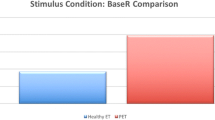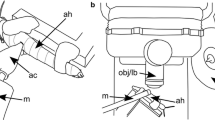Summary
-
1.
Orientation sounds of the echolocating swiftlet,Collocalia spodiopygia (family Apodidae) consist of two clicks, each having a duration of a few milliseconds, separated from each other by a silent interval lasting about 20 ms (Fig. 1). Most of the acoustic energy is between 2 and 8 kHz.
-
2.
These clicks are generated in the syrinx and require syringeal airflow.
-
3.
The first member of the double click is initiated by contraction of the sternotrachealis muscles (Fig. 3) which reduces tension on the syrinx by pulling the trachea caudad (Fig. 2). This causes the first bronchial ring to rotate inward (Fig. 10), reducing the syringeal aperture. As the external tympaniform membrane approaches the internal tympaniform membrane, the subsyringeal (= sternal air sac) pressure rises with increasing syringeal resistance and expiratory tracheal airflow peaks at about 6.1 ml/s (Figs. 6, 7, Table 1). Bernoulli forces cause the internal tympaniform membranes to vibrate, producing the first member of the double click (Fig. 9b).
-
4.
The syrinx is closed during the silent intraclick interval by apposition of the syringeal membranes (Figs. 9c, 10). Subsyringeal pressure peaks at about 17cm H2O during this interval (Fig. 6), which is terminated by contraction of the tracheolateralis muscles (Fig. 3) that moves the syrinx craniad and causes the first bronchial ring to rotate outward, thus abducting the external tympaniform membranes and opening the syringeal lumen (Fig. 9d).
-
5.
The second member of the double click occurs as the internal and external tympaniform membranes begin to separate, allowing expiratory airflow to resume (Fig. 9d). Tracheal airflow peaks at about 10 ml/s during this click as syringeal resistance and subsyringeal pressure drop (Figs. 6, 7, Table 1). The second click is terminated by further abduction of the external tympaniform membranes to their resting position (Fig. 9a).
-
6.
The ability of swiftlets to transform a longer duration squeak-like vocalization into two brief clicks by momentarily closing the syrinx probably represents an important adaptation for acoustic orientation. By generating brief clicks they have created a sonar signal with a greater bandwidth and having abrupt rise-decay times that should improve target range determination based on measurement of the pulse-echo interval.
Similar content being viewed by others
Abbreviations
- EMG :
-
electromyogram
References
Bernstein MH, Schmidt-Nielsen K (1974) Ventilation and oxygen extraction in the crow. Respir Physiol 21:393–401
Brackenbury JH (1972) Lung-air-sac anatomy and respiratory pressures in the bird. J Exp Biol 57:543–550
Brackenbury JH (1978) A comparison of the origin and temporal arrangement of pulsed sounds in the songs of the Grasshopper and Sedge Warblers,Locustella naevia andArcocephalus schoenobaenus. J Zool (Lond) 184:187–206
Brooke RK (1970) Taxonomic and evolutionary notes on the subfamilies, tribes, genera and subgenera of swifts (Aves: Apodidae). Durban Mus Novit 9:13–24
Brooke RK (1972) Generic limits in old world Apodidae and Hirundinidae. Bull Br Ornithol Club 92:52–57
Chamberlain DR, Gross WB, Cornwell GW, Mosby HS (1968) Syringeal anatomy in the common crow. Auk 85:244–252
Duncker H-R (1971) The lung air sac system of birds. A contribution to the functional anatomy of the respiratory apparatus. Ergeb Anat Entwicklungsgesch 45 (6):1–171
Fenton MB (1975) Acuity of echolocation inCollocalia hirundinacea (Aves: Apodidae) with comments on the distributions of echolocating swiftlets and molossid bats. Biotropica 7:1–7
Gaunt AS, Gaunt SLL (1977) Mechanics of the syrinx inGallus gallus: II. Electromyographic studies of ad libitum vocalizations. J Morphol 152:1–19
Gaunt AS, Wells MK (1973) Models of syringeal mechanisms. Am Zool 13:1227–1247
Gaunt AS, Stein RC, Gaunt SLL (1973) Pressure and air flow during distress calls of the starling,Sturnis vulgaris (Aves: Passeriformes). J Exp Zool 183:241–262
Gaunt AS, Gaunt SLL, Hector DH (1976) Mechanics of the syrinx inGallus gallus. I. A comparison of pressure events in chickens to those in oscines. Condor 78:208–223
Griffin DR, Suthers R (1970) Sensitivity of echolocation in cave swiftlets. Biol Bull 139:495–501
Griffin DR, Thompson D (1982) Echolocation by cave swiftlets. Behav Ecol Sociobiol 10:119–123
Harrisson T (1966) Onset of echolocation clicking inCollocalia swiftlets. Nature 212:530
Hollander P (1971) Adaptations for echolocation in cave swiftlets (Collocalia). PhD thesis, Yale University, New Haven, Connecticut
Kulzer E (1960) Physiologische und morphologische Untersuchungen über die Erzeugung der Orientierungslaute von Flughunden der GattungRousettus. Z Vergl Physiol 43:231–268
Lockner FR, Youngren OM (1976) Functional syringeal anatomy of the mallard. I.In situ electromyograms during ESB elicited calling. Auk 93:324–342
Medway L (1967) The function of echonavigation among swiftlets. Anim Behav 15:416–420
Medway L, Pye JD (1977) Echolocation and the systematics of swiftlets. In: Stonehouse B, Persins C (eds) Evolutionary ecology. University Park Press, Baltimore, Maryland, pp 225–238
Miskimen M (1951) Sound production in passerine birds. Auk 68:493–504
Nottebohm F (1971) Neural lateralization of vocal control in a passerine bird. I. Song. J Exp Zool 177:229–262
Phillips RE, Youngren OM (1981) Effects of denervation of the tracheo-syringeal muscles on frequency control in vocalizations in chicks. Auk 98:299–306
Pye JD (1980) Echolocation signals and echoes in air. In: Busnel R-G, Fish JF (eds) Animal sonar systems. Plenum, New York, pp 309–353
Roberts JR, Smyth DM, Spain AV (1976) Preliminary studies on acoustic orientation inCollocalia spodiopygia. Search 7:97–98
Smith DG (1977) The role of the sternotrachealis muscles in bird song production. Auk 94:152–155
Smyth DM (1979) Studies on echolocation by the grey swiftletAerodramus spodiopygius. PhD thesis, Department of Zoology, James Cook University of North Queensland, Townsville, Queensland, Australia
Smyth DM, Roberts JR (in press) The sensitivity of echolocation by the grey swiftlet,Aerodramus spodiopygius. Ibis
Stein RC (1968) Modulation in bird sounds. Auk 85:229–243
Youngren OM, Peek FW, Phillips RE (1974) Repetitive vocalizations evoked by local electrical stimulation of avian brains: III. Evoked activity in the tracheal muscles of the chicken (Gallus gallus). Brain Behav Evol 9:393–421
Author information
Authors and Affiliations
Rights and permissions
About this article
Cite this article
Suthers, R.A., Hector, D.H. Mechanism for the production of echolocating clicks by the grey swiftlet,Collocalia spodiopygia . J. Comp. Physiol. 148, 457–470 (1982). https://doi.org/10.1007/BF00619784
Accepted:
Issue Date:
DOI: https://doi.org/10.1007/BF00619784




